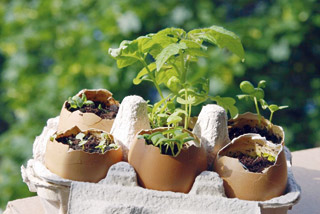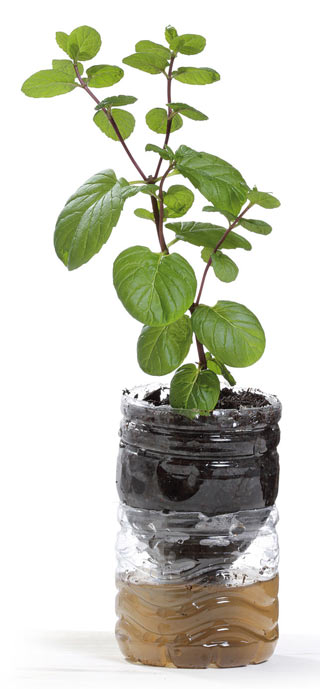Recycling waste has become a commonplace practice today. Whether it is reusing plastic bags or transforming old rubber tyres into furniture, people have realised the ecological value of recycling. Additionally, objects that you would normally throw away can be used to beautify and uplift the energy of your home. One way to achieve this is to use recyclable materials to make planters for your home garden. In addition to enhancing your home décor, these planters can be your contribution to the welfare of the planet. These eight simple ideas for planters are easy to make and only require two things—your time and the willingness to get your hands dirty.
1. Old shoes

If your sneakers are too frayed to wear or your boots have torn soles, then let them be the new home for your plants. You can reuse old canvas shoes, Crocs, gumboots or hiking boots as planters in your garden. Just clean the insides with a damp cloth; poke a few drainage holes with a screwdriver at the bottom; and your shoes are ready for a new life as a planter. You can even try mounting several shoes along a fence or hanging them using the shoelaces for fun.
2. Coconut shells

3. Egg shells
 Egg shells can be the perfect starters for your home garden. Because of their small size and the calcium in the shells, they can give a good start to budding seedlings. The next time you need eggs to make an omelette or bake a cake, make sure you crack them one-third from the top. You can use a knife to gently tap the shell to break it. Wash the shells in cool or warm water once you remove the yolk. Then, either place a small piece of cotton at the bottom or gently pierce a hole using a needle or pin; this is to ensure water does not accumulate. Add a teaspoonful of potting soil and spray a little bit of water. Finally, place the seeds and then layer them with some more soil. Remember to either use the egg carton or small terra cotta pots to support the egg shells.
Egg shells can be the perfect starters for your home garden. Because of their small size and the calcium in the shells, they can give a good start to budding seedlings. The next time you need eggs to make an omelette or bake a cake, make sure you crack them one-third from the top. You can use a knife to gently tap the shell to break it. Wash the shells in cool or warm water once you remove the yolk. Then, either place a small piece of cotton at the bottom or gently pierce a hole using a needle or pin; this is to ensure water does not accumulate. Add a teaspoonful of potting soil and spray a little bit of water. Finally, place the seeds and then layer them with some more soil. Remember to either use the egg carton or small terra cotta pots to support the egg shells.
4. Plastic bottles
 Because they come in varying sizes and are easy to cut, plastic bottles are an ideal addition to your home garden. With a one-litre bottle, cut it at the middle so that you have two almost equal parts. Now place a small muslin cloth around the opening of the top half of the bottle, securing it with a rubber band. Then, turning it upside down, fill this part with soil about halfway up. Place your herb, flower or vegetable plant in the soil and add some more soil over it. Fill the bottom half of the bottle with some water, occupying about one-third of the space. Now place the top half of the bottle in the bottom half.
Because they come in varying sizes and are easy to cut, plastic bottles are an ideal addition to your home garden. With a one-litre bottle, cut it at the middle so that you have two almost equal parts. Now place a small muslin cloth around the opening of the top half of the bottle, securing it with a rubber band. Then, turning it upside down, fill this part with soil about halfway up. Place your herb, flower or vegetable plant in the soil and add some more soil over it. Fill the bottom half of the bottle with some water, occupying about one-third of the space. Now place the top half of the bottle in the bottom half.

5.Using glass or Mason jars.
Make sure the jars are clean and dry. Add about an inch of small to medium-sized stones or pebbles at the bottom for drainage. Then put a mixture of good soil and compost in the jars. You can get composted soil at any gardening store. In the end, you can plant herb saplings or seeds in the jars. If you are using seeds, then make sure they get adequate sunlight [partly shaded] to grow well. Voila! Your herb garden is ready to go.
6. Coffee mugs and tea cups
 Do you have any old or chipped coffee mugs or tea cups? Don’t throw them away. Instead, use them to grow your favourite herbs or flowers. Whether they are giant mugs or dainty cups, you can place them along the windowsill or on a patio or terrace table to bring some green energy to those areas. Follow the same process as for the glass jars. Don’t forget to add a one-inch layer of small rocks or pebbles for proper drainage. You can even paint beautiful patterns on the mugs/cups using acrylic colours to add a personal touch.
Do you have any old or chipped coffee mugs or tea cups? Don’t throw them away. Instead, use them to grow your favourite herbs or flowers. Whether they are giant mugs or dainty cups, you can place them along the windowsill or on a patio or terrace table to bring some green energy to those areas. Follow the same process as for the glass jars. Don’t forget to add a one-inch layer of small rocks or pebbles for proper drainage. You can even paint beautiful patterns on the mugs/cups using acrylic colours to add a personal touch.
7. Tin cans
 Old paint cans or food cans can be great containers for herbs and flowers. You can choose to remove the labels on the cans, or you can keep them if you want to go for a vintage look. Additionally, you can paint beautiful, colourful patterns on drawing-grade papers and then paste them onto the cans. You can even poke a hole on either side of the top of the can, insert a rope or wire and hang it by a window. Again, make sure that you poke three or four holes at the bottom to allow water to seep through. Fill the can, about one-third, with a soil-compost mix. Then place a plant in the can, cover it with more soil and pour some water over it.
Old paint cans or food cans can be great containers for herbs and flowers. You can choose to remove the labels on the cans, or you can keep them if you want to go for a vintage look. Additionally, you can paint beautiful, colourful patterns on drawing-grade papers and then paste them onto the cans. You can even poke a hole on either side of the top of the can, insert a rope or wire and hang it by a window. Again, make sure that you poke three or four holes at the bottom to allow water to seep through. Fill the can, about one-third, with a soil-compost mix. Then place a plant in the can, cover it with more soil and pour some water over it.
8. Rubber tyres

 Spot an error in this article? A typo maybe? Or an incorrect source? Let us know!
Spot an error in this article? A typo maybe? Or an incorrect source? Let us know!
